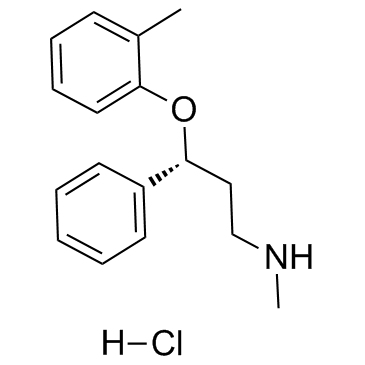Atomoxetine Hydrochloride

Atomoxetine Hydrochloride structure
|
Common Name | Atomoxetine Hydrochloride | ||
|---|---|---|---|---|
| CAS Number | 82248-59-7 | Molecular Weight | 291.816 | |
| Density | N/A | Boiling Point | 389ºC at 760 mmHg | |
| Molecular Formula | C17H22ClNO | Melting Point | 167-169ºC | |
| MSDS | USA | Flash Point | 164.1ºC | |
| Symbol |



GHS02, GHS06, GHS08 |
Signal Word | Danger | |
|
Methylphenidate and atomoxetine inhibit social play behavior through prefrontal and subcortical limbic mechanisms in rats.
J. Neurosci. 35(1) , 161-9, (2015) Positive social interactions during the juvenile and adolescent phases of life, in the form of social play behavior, are important for social and cognitive development. However, the neural mechanisms of social play behavior remain incompletely understood. We ... |
|
|
Atomoxetine prevents dexamethasone-induced skeletal muscle atrophy in mice.
J. Pharmacol. Exp. Ther. 351(3) , 663-73, (2014) Skeletal muscle atrophy remains a clinical problem in numerous pathologic conditions. β2-Adrenergic receptor agonists, such as formoterol, can induce mitochondrial biogenesis (MB) to prevent such atrophy. Additionally, atomoxetine, an FDA-approved norepinephr... |
|
|
Current pharmacotherapy of attention deficit hyperactivity disorder.
Drugs Today (Barc) 49(10) , 647-65, (2013) Attention deficit hyperactivity disorder (ADHD) is a neurobehavioral developmental disorder in children and adults characterized by a persistent pattern of impulsiveness, inattention and hyperactivity. It affects about 3-10% of children and 2-5% of adolescent... |
|
|
[ADHD register: post-marketing evaluation of the benefit-risk profile of drugs and promotion of the appropriateness].
Recenti Prog. Med. 104(6) , 254-61, (2013) The Register was aimed at assessing the benefit-risk profile of the treatment of attention deficit hyperactivity disorder (ADHD) with atomoxetine and methylphenidate.Post-marketing observational study, phase IV. Prescription medication to children and adolesc... |
|
|
[Life-threatening heart failure caused by ADHD medication. Five case reports described].
Lakartidningen. 109(45) , 2016-8, (2012)
|
|
|
Physical exercise and catecholamine reuptake inhibitors affect orienting behavior and social interaction in a rat model of attention-deficit/hyperactivity disorder.
Behav. Neurosci. 126(6) , 762-71, (2012) The effects of methylphenidate (MPH), atomoxetine (ATMX), and/or physical exercise (EX) on orienting behavior and social interaction were examined in spontaneously hypertensive rats (SHRs), a commonly used animal model of attention-deficit/hyperactivity disor... |
|
|
Effects of atomoxetine on locomotor activity and impulsivity in the spontaneously hypertensive rat.
Behav. Brain Res. 243 , 28-37, (2013) Atomoxetine (ATX) is a commonly used non-stimulant treatment for Attention deficit hyperactivity disorder (ADHD). It primarily acts to increase noradrenalin levels; however, at higher doses it can increase dopamine levels. To date there has been no investigat... |
|
|
[Diagnosis and treatment of attention deficit hyperactivity disorder in adults].
Rev. Neurol. 54 Suppl 1 , S105-15, (2012) To review the latest data available concerning the diagnosis and treatment of adults with attention deficit hyper-activity disorder (ADHD).A number of different instruments for evaluating ADHD have been adapted to the adult patient and allow a reliable diagno... |
|
|
Amphetamines, atomoxetine and the risk of serious cardiovascular events in adults.
PLoS ONE 8(1) , e52991, (2013) To compare the incidence rates of serious cardiovascular events in adult initiators of amphetamines or atomoxetine to rates in non-users.This was a retrospective cohort study of new amphetamines (n=38,586) or atomoxetine (n=20,995) users. Each medication user... |
|
|
Effects of norepinephrine reuptake inhibition on postural tachycardia syndrome.
J. Am. Heart Assoc. 2(5) , e000395, (2013) Postural tachycardia syndrome (POTS) is a disorder of chronic orthostatic intolerance accompanied by excessive orthostatic tachycardia. Patients with POTS commonly have comorbid conditions such as attention deficit hyperactivity disorder, depression, or fibro... |